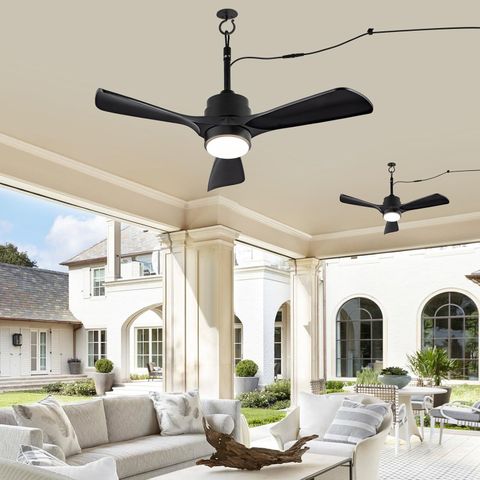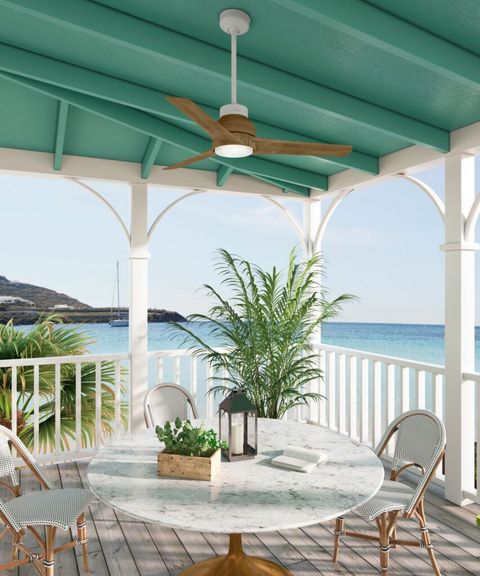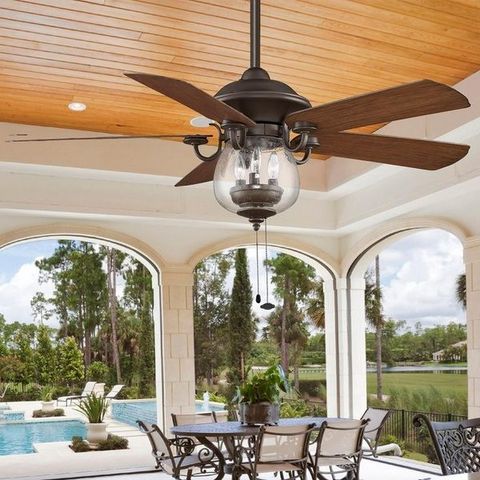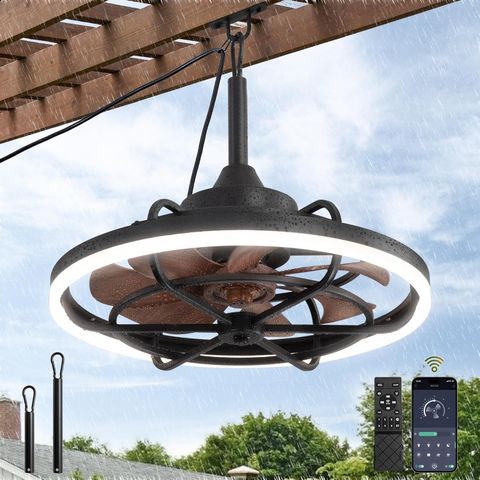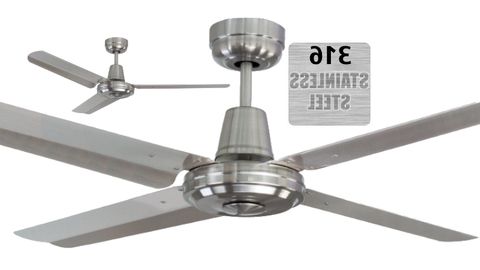Picture this: you’re relaxing on your semi-open terrace, feeling the gentle breeze, when suddenly the heat becomes unbearable. You think, ‘I need a ceiling fan.’ But what happens when you try to install one? The wrong approach can lead to disasters. This guide explores the most common pitfalls and how to avoid them.
Installing ceiling fans on semi-open terraces isn’t just about hanging something from the ceiling. It’s about balancing comfort, safety, and structural integrity. These outdoor spaces present unique challenges that indoor installations simply don’t face. Whether you’re building a new space or retrofitting an existing terrace, understanding these challenges can save you from costly mistakes and potential dangers. Many people rush into installation without considering the environmental factors, structural requirements, and weather considerations that make these projects different from indoor fan installs.
Understanding the Unique Challenges of Semi-Open Spaces
Semi-open terraces present a different set of problems compared to fully enclosed rooms. The main issue? Exposure to the elements. Wind, rain, and temperature fluctuations all impact how fans perform and last. Think about it – while indoor fans deal with air circulation, outdoor fans must withstand humidity, UV rays, and varying temperatures.
Consider this scenario: someone installs a regular indoor fan on a semi-open terrace. Within months, the blades start rusting, the motor overheats, and the whole thing becomes a safety hazard. Why? Because indoor fans aren’t built for outdoor conditions. The materials used inside don’t handle moisture and weather changes well. This leads to premature failure and potential accidents.
The key takeaway here is that you need specialized equipment designed for outdoor use. Regular indoor fans simply won’t cut it in these environments.
Structural Considerations That Can Make or Break Your Installation
Before even thinking about mounting anything, you must assess the structural strength of your terrace. This is where many people make their biggest mistake. They assume the ceiling can handle the weight and vibration of a ceiling fan, but they’re often wrong.
Let’s break this down:
• Ceiling type matters: If you have a concrete ceiling, it might support a fan easily. But if it’s a wooden beam structure or drywall, you’ll need to reinforce it properly.
• Weight capacity: Most ceiling fans weigh between 15 and 40 pounds. Add to that the weight of the mounting hardware and any additional accessories. That’s significant weight for some structures to bear.
• Vibration concerns: Fans create vibrations that can cause damage over time. In a semi-open space, these vibrations might be amplified by wind or other external forces.
A real-life example shows someone installing a heavy fan on a weak ceiling structure. Within weeks, the ceiling started sagging, and the fan wobbled violently. The fix required expensive ceiling repairs and a complete replacement. This could have been avoided with proper structural assessment first.
Always check with a professional if you’re unsure about load-bearing capabilities.
Weather Protection and Material Selection
This is where most people get it completely wrong. They think any outdoor fan will do, but that’s a dangerous assumption. The right materials can mean the difference between a fan that lasts years and one that fails within months.
Key material considerations include:
• Corrosion resistance: Look for fans made with aluminum, stainless steel, or treated wood. These materials handle moisture much better than regular materials.
• Weatherproofing rating: Check for IP ratings (Ingress Protection). An IP44 rating means protection against solid objects larger than 1mm and water splashes. For terraces, aim for at least IP54 for better protection.
• UV resistance: Sunlight breaks down materials over time. Choose fans with UV-resistant coatings or materials that naturally resist sun damage.
A common error is using standard indoor fans outdoors. These typically lack the protective features needed. The blades warp, the motor overheats, and the electronics fail quickly. One homeowner installed a standard fan and was disappointed when it broke down after just six months.
Invest in quality outdoor-rated components. It costs more upfront but saves money in replacements and repairs.
Mounting Hardware and Installation Techniques
The mounting process itself is where things often go wrong. Using the wrong hardware or improper techniques can lead to dangerous situations.
Here’s what you need to know:
• Proper anchors: Use appropriate anchors for your ceiling type. Drywall needs special anchors; concrete requires different fasteners. Using the wrong anchor can cause the fan to fall.
• Sufficient screw length: Make sure screws are long enough to grip the structure securely. Too short and they won’t hold. Too long and they might damage electrical wiring or other systems.
• Professional installation: While some people attempt DIY installation, complex mounting on semi-open terraces often requires professional expertise. The combination of structural considerations and weather exposure makes this a job best left to experienced hands.
One handy tip: always double-check that all mounting hardware is rated for ceiling fan use, not just general ceiling fixtures. They’re built differently and handle the load differently.
Another mistake: not accounting for the fan’s weight when selecting mounting brackets. A bracket rated for 50 pounds won’t work if your fan weighs 60 pounds.
Wind Load and Safety Factors
Wind loads become a major concern on semi-open terraces. Unlike closed rooms where air movement is controlled, terraces experience variable wind conditions that can dramatically affect fan performance and safety.
What you need to consider:
• Wind speed tolerance: Different fans have different wind load specifications. Make sure your fan can handle expected wind speeds in your area.
• Blade design: Some blade designs handle wind better than others. Look for fans specifically designed for outdoor use with aerodynamic blade shapes.
• Safety clearance: Ensure there’s adequate clearance around the fan for safe operation. People shouldn’t be able to accidentally touch moving blades.
A case study from Florida illustrates this perfectly. During hurricane season, a poorly installed fan failed due to inadequate wind load calculations. The fan detached from its mount and became a projectile, causing property damage and injuries.
This isn’t just theoretical. Real-world incidents show how important proper wind load considerations are. Always check local building codes for wind load requirements specific to your area.
Electrical Safety and Weatherproof Connections
Electrical connections in outdoor environments require extra attention. Moisture, temperature changes, and physical stress can all compromise electrical safety.
Critical points to remember:
• Waterproof connections: All electrical connections must be properly sealed and protected from moisture.
• GFCI protection: Ground Fault Circuit Interrupter outlets provide crucial safety protection against electrical shocks in wet environments.
• Proper wire gauge: Outdoor installations often require thicker wires to handle the conditions and prevent overheating.
• Cable management: Protect electrical cables from weather and physical damage. Use conduit or proper cable covers.
A recent incident involved a homeowner who didn’t properly seal electrical connections. During a rainstorm, water entered the junction box, causing a short circuit and potentially starting a fire. This could have been prevented with proper weatherproofing.
Always use outdoor-rated electrical components and follow local electrical codes. When in doubt, consult with a licensed electrician.
Installing ceiling fans on semi-open terraces is definitely doable, but it requires careful planning and attention to detail. The key is understanding that these installations differ significantly from indoor setups. From choosing the right materials and assessing structural capacity to ensuring proper electrical connections and wind load considerations, every aspect matters.
Don’t let the temptation to save money on materials or installation lead to dangerous situations or expensive repairs. Take time to plan properly, invest in quality outdoor-rated components, and consider professional help when needed. Remember, a well-installed fan will provide years of reliable service, keeping you comfortable on your terrace regardless of weather conditions.
The goal isn’t just to install a fan – it’s to install one that works safely and effectively for years to come. With the right approach and awareness of these common pitfalls, your terrace can remain a cool, comfortable retreat throughout all seasons.
